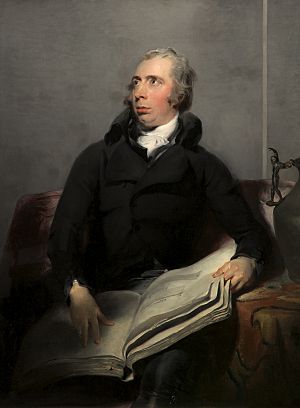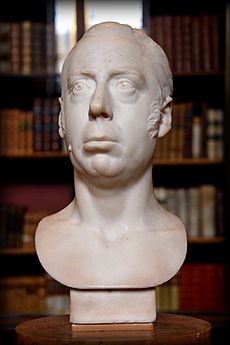Richard Payne Knight facts for kids

Richard Payne Knight (born February 11, 1751 – died April 23, 1824) was an important English gentleman. He lived at Downton Castle in Herefordshire and in London. He was known for his love of ancient art and coins. He also studied old cultures and wrote about what he thought made things beautiful.
Richard Payne Knight was also a Member of Parliament, which means he was part of the government. He represented the areas of Leominster (from 1780 to 1784) and Ludlow (from 1784 to 1806).
Contents
Early Life and Family
Richard Payne Knight was born in a place called Wormsley Grange in Herefordshire. He was the oldest son of Reverend Thomas Knight. His mother was Ursula Nash.
Richard inherited a lot of money and land. This came from his father, his uncle Richard Knight, and especially from his grandfather, also named Richard Knight. His grandfather was a very rich Ironmaster, someone who owned ironworks and made metal. This wealth helped the family become very important. Richard's younger brother was Thomas Andrew Knight, who became famous for studying plants.
His Career and Travels
Richard Payne Knight was taught at home. He wasn't very healthy when he was young, so he didn't go to a regular school for long. But because his family was wealthy, he could travel a lot to learn.
Starting in 1767, he went on a long trip called the Grand Tour. He traveled through Italy and other parts of Europe. During these travels, he started collecting old bronze statues and ancient coins. He also wrote many books and articles about old sculptures, coins, and other historical items.
Richard was part of a group called the Society of Dilettanti. This group was made up of people who loved and studied ancient art. Many people looked to him as an expert on what was considered good taste in art. He also spent a lot of time studying and preparing an edition of the ancient Greek epic poems by Homer.
He served as a Member of Parliament for many years, from 1780 to 1806. He mostly watched the debates rather than taking a big part in them. Later in his life, starting in 1814, he became a trustee of the British Museum. This meant he helped manage the museum. When he died, he gave his amazing collection of bronzes, coins, engraved gems, marbles, and drawings to the British Museum.
Later Life and Legacy
Richard Payne Knight never married. He passed away on April 23, 1824. He was buried in the churchyard of St Mary's Church, Wormsley. His grave is still there and is now a protected historical structure.
His brother, the plant expert Thomas Andrew Knight, inherited most of his property. Thomas's daughter, Charlotte Knight, later inherited Downton Castle. The castle then passed to her children and their families.
Richard also left all his coins and medals to the British Museum. He had a special condition: a male descendant from his grandfather's family line should always be a trustee of the museum. This was to make sure his family continued to be involved with the museum.
A Family Legal Case
Richard Payne Knight wrote his will in 1814. He wanted his property to stay in the male family line. However, his brother Thomas died without any living sons. This meant that Thomas's daughter, Charlotte, was the next in line.
One of Richard's male cousins, John Knight, argued that Charlotte, as a female, should not inherit the property. This led to a famous court case in 1840 called Knight v Knight. The judge looked closely at Richard's will. Richard had written, "I trust to the liberality of my successors... to their justice in continuing the estates in the male succession..."
The judge decided that these words showed Richard did not intend to create a strict legal rule that only males could inherit. Instead, he trusted his family to do what he wished. Because of this, the judge ruled that Thomas had fully inherited the property from Richard. This meant Charlotte, as Thomas's daughter, had the legal right to inherit it.
His Ideas on Art and Beauty
Richard Payne Knight was very interested in what makes things beautiful and how we experience art. He wrote an important book called An Analytical Inquiry into the Principles of Taste in 1805. In this book, he tried to explain how our minds understand "taste" and beauty.
He talked about something called the "picturesque." For him, "picturesque" simply meant "like a painting." He believed that when we look at a painting or listen to music, we feel direct sensations. But when we read poetry or look at sculptures, our minds use ideas and feelings to understand them.
Knight thought that artists should try to show these direct sensations in their work. For example, he believed that a pure blue color is pleasing because of the feeling it gives us, not just because it reminds us of a clear sky. He also thought that mixing and varying colors was the most pleasing.
He believed that a beautiful Roman temple is beautiful because of its perfect proportions. But he argued that we don't see these proportions directly with our eyes. Instead, our minds interpret what we see to understand the beauty. This meant that "beauty" is something our minds create.
Knight's ideas were very important for later artists and thinkers, especially during the Romantic and Victorian periods. His thoughts helped shape how people understood art, feelings, and beauty.
See also
- Knight v Knight (1840) 3 Beav 148



